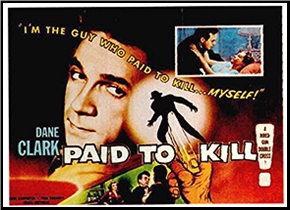November 2018
Monthly Archive
Sat 24 Nov 2018
Posted by Steve under
Reviews1 Comment

RICHARD C. SMITH – A Secret Singing. James Maxfield Mallory #1. Dutton, hardcover, 1988. Signet AE5969, paperback, September 1989.
The problem with this book is that there are too many lawyers in it. While its hero, John Maxfield Mallory, is a PI, he’s also a Harvard grad who went to law school for a year. His lady friend Julie is an up-and-coming corporate attorney. Some of his best contacts are lawyers. Even one of his prime suspects (a case of murder) is a lawyer.
And it’s no wonder, since author Richard C. Smith is a lawyer himself, and the story he tells in A Secret Singing takes place a long way from Boston’s nastier streets. This urban, citified PI adventure hints at only a few of the upper class’s darkest secrets, however. Spenser has nothing to worry about.
–Reprinted from Mystery*File #18, December 1989, slightly revised.
Bibliographic Note: Mallory’s second and final case outing was Wild Justice (St. Martin’s, 1990; no paperback edition).
Fri 23 Nov 2018
REVIEWED BY DAN STUMPF:
THE PHANTOM SPEAKS. Republic, 1945. Richard Arlen, Stanley Ridges, Lynne Roberts, Tom Powers and Charlotte Wynters. Written by John K. Butler. Directed by John English.
THE MAN WITH TWO LIVES. Monogram, 1942. Edward Norris, Addison Richards, Marlo Dwyer, Eleanor Lawson, and Edward Keane. Written by Joseph Hoffman. Directed by Phil Rosen.

Back in 1940, Universal made BLACK FRIDAY, which you may read about here. It’s about a gangster resurrected in the brain and body of a respectable professor (Stanley Ridges) and I have nothing to add to that review except that the story itself was resurrected twice by other studios.
PHANTOM SPEAKS is the most obvious crib, with plot trajectory, minor details and characters lifted directly from the earlier film. More to the point, Stanley Ridges repeats his role as the gentle man of learning possessed by the spirit of a dead guy — increasing the eerie feeling of a movie come back to haunt us.

In this case he’s rather asked for it, since he’s doing research into the paranormal and taken the logical (in spooky movies) step of contacting a killer on Death Row (Tom Powers, who was memorably offed by Fred MacMurray in DOUBLE INDEMNITY) and urging him to make contact from the beyond. Ridges makes himself receptive to Powers’ spirit, then finds the dead man’s will too strong to resist, sending us into BLACK FRIDAY territory, right up to a gritty ending back on Death Row, where the earlier film ended up as well.
All this is directed with more energy and finesse that it deserves by John English, Republic’s serial ace, who throws in some noirish bits and keeps things moving, moving, moving, with the happy result of a film easier to watch & enjoy than you’d think.
In between times, Monogram stuck in its tawdry oar with THE MAN WITH TWO LIVES, which is at once less polished and more interesting than either PHANTOM SPEAKS or BLACK FRIDAY.

In this case, Edward Norris plays one of those bright young men you see in the movies, unfortunate enough to get run over by a car (another nod to BLACK FRIDAY) and killed outright. Fortunately for him and the story, his dad knows a doctor who has been experimenting with resuscitating dead animals, and he persuades his old buddy to have a go at sonny boy.
The experiment succeeds, but just at that moment, a nasty gangster is executed for his crimes, and his spirit…. well you figured that out. This Monogram film is a shabby take-off on BLACK FRIDAY, but considerably grittier, with Norris taking over the dead man’s gang, bedding his floozy and leading the boys on an abortive heist that turns deadly.

There’s even a bit of intelligent writing and deft playing in a tense cat-and-mouse exchange, with Norris holding a gun on the police detective (Addison Richards) who has him surrounded, each trying to talk his way around the other with an eye out for the main chance.
All of which does very little to dispel the feeling of cheap imitation that was a hallmark at Monogram: the sets are shabby, the camera work perfunctory, and the direction largely absent. Yet I find myself fascinated by the notion that BLACK FRIDAY, like its monster, never really died.
Thu 22 Nov 2018
JEFFERY WILDS DEAVER – Hard News. Rune #3. Doubleday, hardcover, 1991. Bantam, paperback, June 1992.

Rune, not her real name, but the name she goes by, is an aspiring photojournalist and filmmaker living in a houseboat on the Hudson River in Manhattan. She’s in her early 20s, and as taken from Jeffrey Deaver’s website, she’s “five feet two inches of slick repartee, near-purple hair, and poetic imagination” with “with more ambition than political savvy.”
A description which doesn’t entirely do her justice, but it’s close enough. In Hard News, after watching a videotaped interview with him, she becomes convinced that a convict named Randy Boggs is actually innocent of the murder he claims he didn’t commit.
Where does she take her story on him to prove his innocence? Directly to Piper Sutton, the news anchorwoman for Current Events, one of the mostly highly watched TV news programs on the air. Somehow she manages to persuade Sutton to go ahead with the project. (It may have something to do with the fact that the man murdered was the head of the network at the time.)
All to the good. But do things go smoothly? In a word, no. She does manage to stir up a lot of trouble for both herself and the man in prison. Rune’s life style is, shall we say, somewhat unique, making for a story that’s a lot of fun to read. What makes it even more so is the fact she does all of the work on her project burdened down by a three-year-old girl whose mother abandoned her in Rune’s care.
Even as early as this in his career Jeffery Deaver, well-known now as the author of a long list of books about quadriplegic detective Lincoln Rhyme, had a way with words, turns of phrases and twists in the tale he’s telling that titillates the reader’s mind and teases one’s brain. The story, while rushed in the ending, isn’t at all bad either.
Bibliographic Note: At the end of the paperback edition, which I’ve just read, the next Rune book was announced as being The Mystery of You, to be released in January 1993. The book was never published. I wonder if it was ever written.
The Rune series —
Manhattan Is My Beat. Bantam 1989
Death of a Blue Movie Star. Bantam 1990
Hard News. Doubleday 1991
Thu 22 Nov 2018
Wed 21 Nov 2018
IONE SANDBERG SHRIBER – Pattern for Murder. Lt. Bill Grady #7. Farrar & Rinehart, hardcover, 1944. Detective Book Club, hardcover reprint, 3-in-1 edition. Armed Services Edition #798, paperback. Mercury Mystery #113, digest-sized paperback (slightly abridged).

With all of the above options available, unfortunately I had to settle for the one that was abridged. I’ve never checked to see what kind of editing job was done by the people at Mercury and their line of mystery paperbacks, but I’m hoping I didn’t miss too much with this one. I don’t think so, but I’m saying that with my fingers crossed.
And a word about Grady, the police detective on the case. He appeared in eight of of the eleven mysteries written by author Ione Sandberg Shriber between 1940 and 1953. In Pattern for Murder he’s almost always referred to only as Grady. His first name of Bill is used only once, as I recall. Once he’s called Major, never as Lt. Grady, but other sources all agree that that’s his proper title.
The use of “Major” may have come from his Army days; he’s accompanied on his investigation in this one by a chap named Hemingway who lives with Grady and appears to be a sort of aide-de-camp. Readers of earlier books in the series may know more about both gentlemen, but this is not the kind of mystery novel that pays any attention to its detective’s background or personal life.
And in fact he does not show up or is even mentioned until page 49 of the 126 page edition I read. It takes that long to set up the situation — one of those very, very dysfunctional that show up awfully often in 1930s and 40s mystery fiction — and believe it or not, I was looking at the page number, which just happened to be 47, when I was trying to decide whether to keep reading or not.
I’m glad I did, though. This turned out to be quite a decent work of detective fiction, with lots of suspects, alibis, red herrings and so on. The story is largely told from the perspective of an outsider, Miss Katy Sturtevant, who comes to the home of an old college friend to be the maid of honor at her wedding.
But her friend is not marrying the man Katy expects, but her guardian, who is many years only. The man Katy expected to be the groom is already married, as it turns out, and to the daughter of Shannon’s guardian. There are several other relatives on hand as well, including a sister, an aunt and a cousin, only the latter of whom seems to be leading a normal life, plus a ultra-fat gentleman who turns out to be the family lawyer, along with a nurse and a missionary to China in the US now trying to raise funds for a trip back.
Once started, though, the focus is which one of these could be a killer. It’s enjoyable ride, albeit a very somewhat disjointed one. As an author, Shriber has an annoying habit of ending one chapter with what seems to be a major revelation, only to jump in time to begin the next one. It’s a bit disconcerting, that’s all, no more than that, I assure you. Fans of the books published by the late lamented Rue MOrgue Press will love this one.
The Lt. Bill Grady series —
The Dark Arbor. Farrar 1940
Head Over Heels in Murder, Farrar 1940
Family Affair. Farrar 1941
Murder Well Done. Farrar 1941
A Body for Bill. Farrar 1942
Invitation to Murder. Farrar 1943
Pattern for Murder. Farrar 1944
The Last Straw. Rinehart 1946
Wed 21 Nov 2018
REVIEWED BY BARRY GARDNER:

WENDI LEE – The Good Daughter. Angela Matelli #1. St. Martin’s, hardcover, 1994; paperback, 1996.
Lee is [at the time of this review] the Associate Editor of Mystery Scene, and is married to Terry Beatty. artist of the Max Allan Collins-written crime comic, Ms. Tree. This is her first novel, though she has published short stories featuring Angela Matelli.
Matelli is an ex-Marine, member of an extended Italian family, and a brand-new PI hanging out her shingle in Boston. She has an ex-cop uncle (“No-Legs” Charley), and a mother and a good sister and a bad sister. Her first case comes to her on her first day through the auspices of the previously mentioned uncle — an ex-cop friend of his wants Angela to investigate a man his daughter is seeing, because he has a bad feeling about him. Something is wrong somewhere. because very quickly her client is killed and Angela herself is attacked.

A brief aside, telling you that the client is killed is exactly the sort of plat point that I don’t like to see revealed in reviews, but the cover copy gives it away, so why not?Blurb writers are worse than reviewers, sometimes. Often.
This wasn’t bad. It has the typical focus on family/friend relationships that’s part of almost every mystery write by women, and here they verge on being, but aren’t quite, the irritating kind that ruin so many of the current crop of crime books for me.
Matelli is a nicely drawn and appealing character, and already stands out from the crowd by not falling for a cop or a suspect in her first book. Lee’s writing is competent and her pacing good, and if she doesn’t know Boston like the back of her hand, she fakes the hell out of it,
The plot was decent except for one major hole: the client could gave easily done what Matelli did, which was go to a friend on the police and have the background on the suspect dug up. Overall I don’t think Lee is or has the potential to be a threat to any of the top-line PI writers, but she’s certainly better than some.
— Reprinted from Ah Sweet Mysteries #17, January 1995.
The Angela Matelli series —
Novels:
The Good Daughter (1994)
Missing Eden (1996)
Deadbeat (1999)
He Who Dies (2000)
Habeas Campus (2002)
Short stories:
“Salad Days” (Winter 1994, Noir)
“The Disappearance of Edna Guberman” (1994, Murder For Mother)
“Check Up” (1996, Lethal Ladies)
“The Other Woman” (1997, Vengeance Is Hers)
Tue 20 Nov 2018
JAMES KIERAN – Come Murder Me. Gold Medal #150, paperback original, 1951; #419, 2nd printing, 1954.

Whee-eew. Here’s the kind of story that simply takes your breath away, for sheer audacity of plot, if nothing else. A man with a split personality — the kind that kicks up on him whenever his lady friend walks out on him — blanks out and hires an unknown killer. The target: himself.
There’s another girl in the story. She’s a witness to a cop killing in California, and she’s got a gunman on her trail, too. Guess whose apartment she takes refuge in? The tangled plot lines are told in a pulpy sort of fashion and are great fun, but I also have to add that there aren’t any great surprises either.
FOOTNOTE: This is the same John Kieran who was the brother of Helen Reilly, and who is described in Barzun & Taylor as a journalist and radio star. This was his only crime novel. [He died the year after this book was published.] It might also be worth pointing out that two of Reilly’s daughters were Ursula Curtiss and Mary McMullen. I wonder what the family talked about at the breakfast table.
–Reprinted from Mystery*File #18, December 1989, very slightly revised.
[UPDATE] 11/20/18. Observant readers of this blog will immediately recognize that the basic plot line is the same as that of Paid to Kill, the movie reviewed just before this one. Believe it or not, this was almost entirely coincidental.
Tue 20 Nov 2018
PAID TO KILL. Lippert Pictures, US, 1954. First released in the UK as Five Days (Hammer Films, 1954). Dane Clark, Cecile Chevreau, Paul Carpenter, Thea Gregory, Anthony Forwood. Screenwriter: Paul Tabori. Director: Montgomery Tully.
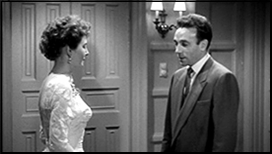
This a film that’s been recently released in a box set of DVDs as a collection of “Hammer Noir” films, and while it’s slower moving than I’d like, the basic plot line is very much noirish in nature, and some of the scenes do show some stylish black-and-white touches. (More on this later.)
It’s hard to say what a British company called Amalgamated Industries actually does, but Dane Clark, even though obviously American, is the head of it. He’s been doing well on the job until he takes one gamble too many, and when the deal fails to go through, the company is ready to go down the toilet with it.
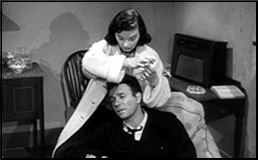
With no other recourse at hand, he blackmails a business associate into killing him so that his wife will receive his insurance money. (Insurance companies do not pay off in cases of suicide.)
Well, at this point we all know where this s going, don’t we? The bad deal goes through, and life is livable again. But the would-be killer can’t be found in order to call the whole thing off. Not even Dane Clark’s highly efficient private secretary (who is obviously but quietly in love with him) can find a trace of him.
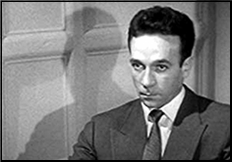
There are some twists that follow in this otherwise very familiar story line, which are all to the good, but it’s the final scene that’s the icing on the cake — and makes this film as noir as noir could be. I wish I could tell you about it, I really do, but I think it best that I don’t.
The story is better than good, to sum things up, and the acting, while a little flat at times, is as good as it needs to be. I like Dane Clark as an actor, but on the screen I’d have to admit that he’s often brooding and moodier than he really needs to be, with a hint of some hidden demons deep inside, or am I the only one who sees that?
Sun 18 Nov 2018
D. B. NEWTON “The Claim Jumpers.” Novella. First published in Best Western, September 1952 as “Who’ll Take the Cowgirl?” First collected in Range of No Return (Five Star, hardcover, 2005; Leisure, paperback, December 2006).
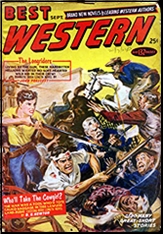
In his long foreword to the two-story book collection, Jon Tuska makes the case for his theory that D(wight) B(ennett) Newton would be a lot more known today if he hadn’t been pushed by his agent to have much of his work published under pseudonyms. Names other than his own that he used over the years were Dwight Bennett, Clement Hardin, Ford Logan, Dan Temple and Hank Mitchum (eight of the long-running “Stagecoach” series in the 1980s).
There’s a lot of truth in that statement. I’ve enjoyed all of the novels I’ve read by the above “authors,” and going back to the later years of his pulp-writing days, both of the two stories in Range of No Return are very well done. (His first published pulp western was in 1938, and over the years he wrote 150 or so more of them.)
“The Claim Jumpers” takes place at an actual event, the Cherokee Strip Land Run (Oklahoma, 1893), as have many other stories and dramatic films over the years. Newton’s story does not rely on its historical significance, however. Rather it’s one told on a personal basis, which to me makes it all the more effective. When three cowpoke partners lose their fourth in the plan they’ve come up with, one of them succumbs to the charms of a woman he happens to meet, and he asks her to help them out.
Things don’t go well, however. Someone seems to have leaked their plans to some Sooners who have settled into the land the partners had planned on settling, and they’re well equipped with guns. Did the girl betray them? All signs point to it.
This is a story that combines a historical background with both action and characters that have some character to them, and at 70 pages, there’s plenty of time for Newton to develop both.
***

— “Range of No Return.” Short novel. First appeared in Complete Western Book Magazine, June 1949. Also first collected in Range of No Return (see above).
And if anything, “Range of No Return” is even better. At almost twice the length of “The Claim Jumpers,” the action is nearly non-stop, but more than that, it fits in naturally with the story Newton has to tell. No gunfire for the sake of gunfire.
Which is that of a young rancher who was framed for rustling cattle in his home town five years ago. With the sheriff’s assistance, who believed him innocent, he made tracks for Mexico, but now that his notoriety has died down, or so he hopes, he’s back, trying to pick up where he left off before his troubles began.
But he’s wrong. The local ranchers have not forgotten, including the female owner of the ranch next to his. There are a couple of small twists in the tale from this point on, but they’re, I admit, only minor ones. But Newton has a good eye for describing his characters, as well as the area of Arizona hills and grasslands he places them in. Even though the basic story line is a familiar one, this is a solid piece of writing.
If you’re a fan of western yarns, you could do a lot worse than to check out more of Newton’s stories, even his early purely pulp fiction. It’s better than most.
Sun 18 Nov 2018

SICARIO. Lionsgate, 2015. Emily Blunt, Benicio Del Toro, Josh Brolin, Victor Garber. Director: Denis Villeneuve.
When a young female FBI agent (Emily Blunt) is recruited to join an elite task force assigned to bring down a Mexican drug cartel, she agrees readily enough, but when she shows up for work, she finds herself on the outside and along only for the ride.

And this is the problem. Not only is she totally confused as to what it that’s going on and what it is she should be doing, so is the viewing audience — and so was the scriptwriter. The story makes no sense at all.
As it turns out, the task force is doing things totally illegally as far as respect of international borders is concerned. The ends justify the means? Well, maybe. The drug cartel and its elusive boss are doing very nasty things, and they deserve to be brought down. But why recruit someone who plays it straight and goes strictly by the book?

It is also not to say that Emily Blunt is at all convincing as a tough head of a FBI SWAT team. She’s far too slight in size and stature. She’s a little girl playing with the big kids on the block in dress-up clothes. She’s very good at sitting in a car or a bus looking out the window wondering what it is that’s going on, but little else.
Nor is the ending worth waiting for. It’s very dramatic, I grant you, and we do find out two things: (1) why Benicio Del Toro’s brooding liaison character has been hanging around since the beginning of the operation, and (2) the meaning of the film’s title (which translated means “Hitman,” or so I’m told).

But when it comes down to it, Emily Blunt’s character is shoved aside for a good portion of the end of the film. While this does allow the real story to be told, it’s very unsatisfying that she’s not there to be part of it. Emily Blunt is the star of the movie, but there’s almost no reason she had to be in it. (Of course, if she isn’t, there’s no conflict of ideas, and it’s an entirely different story than the screenwriter intended to tell.)
A complicated film, in other words, but one that just didn’t connect with me. The photography is nice, though.
« Previous Page — Next Page »



